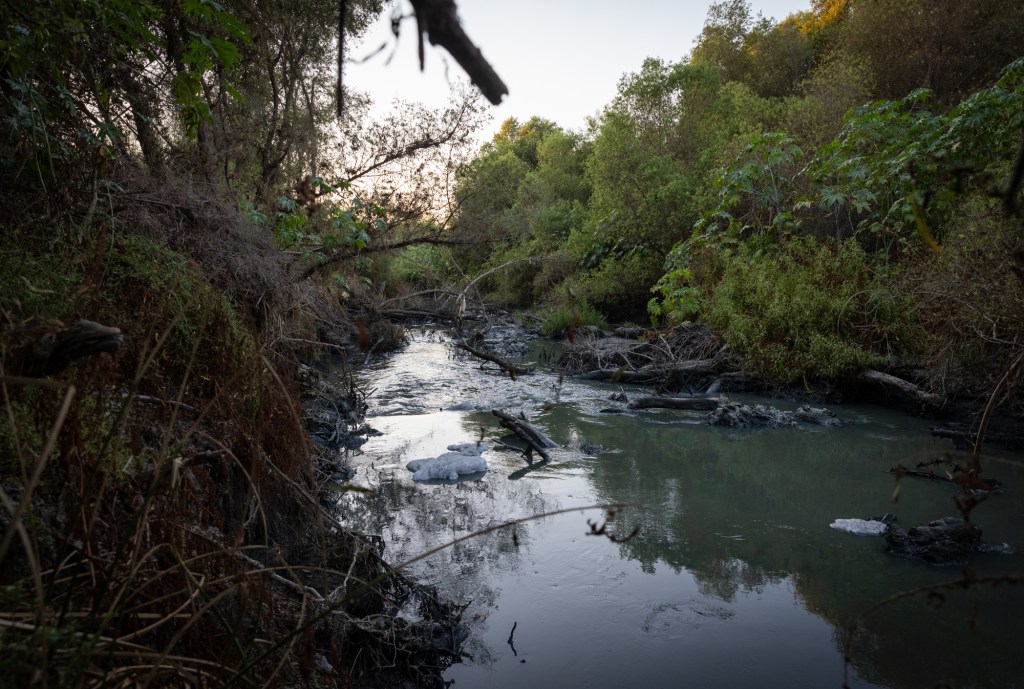

Similar to alerts issued when wildfire smoke degrades air quality, the public now has guidelines for what to do if Tijuana River sewer gases surpass certain levels.
The San Diego County Air Pollution Control District on Wednesday unveiled a color-coded air quality index specific to hydrogen sulfide, a gas detected in various parts of South County due to untreated wastewater in the cross-border region.
Communities such as Nestor, Otay Mesa West, Egger Highlands, San Ysidro, Imperial Beach and as far north as Chula Vista have been reporting to the district and government agencies that the rotten egg-like odors are more than just a nuisance. They are experiencing symptoms such as nausea, headaches, dizziness and chronic coughs.
How will the public know when and what actions to take?
They can refer to the district’s newly launched online dashboard, which shows hourly levels of hydrogen sulfide tracked from Nestor and San Ysidro. Readings from Imperial Beach City Hall will also be available in the coming weeks.
Then they can check where those levels fall within the four color-coded tiers:
- Green: If monitors detect hydrogen sulfide levels at 4.9 parts per billion (ppb) for one hour, no action is needed because most people won’t smell the odor.
- Yellow: If levels are anywhere between 5 ppb and 29.9 ppb for an hour, people sensitive to the sewer gas stench are advised to limit outdoor activities.
- Orange: At 30 ppb (the state standard) or higher for an hour, many could experience odor-related symptoms such as headaches and respiratory discomforts. People are encouraged to shut their doors and windows and air out their homes after odors are gone. Air conditioners and purifiers should be on if available. And those with asthma or other respiratory problems should have their medications readily available. Schools are advised to limit outdoor activities or switch to indoor alternatives for students and to alert parents who have children with respiratory or heart conditions to talk to their family doctor.
- Purple: At more than 27,000 ppb for an hour, people could experience serious, lasting adverse health effects. First responders would evaluate whether people need to shelter in place or evacuate.
District officials said the guidelines were developed with help from the county, state public health department, the U.S. Environmental Protection Agency and the federal Agency for Toxic Substances and Disease Registry.
The effort came after scientists studying the health and environmental impacts of the sewage crisis said in September they found concerning levels of hydrogen sulfide coming from the river. “The community experienced an unprecedented increase in the intensity of odors resulting from high sewage flows, inadequate infrastructure maintenance, and extreme heat,” the district said. Hot spots were detected near schools and homes. In response, some South County schools kept their students indoors, members of Congress renewed calls for a federal state of emergency and the county sent its hazmat team to check gas levels.
The county couldn’t produce the high readings, acknowledging that several factors, such as the wind, could affect outcomes. So county leaders told the public that their health faced no immediate threat. But the mixed messaging confused and infuriated many.
Officials agreed a more collaborative approach was needed to better and consistently monitor the air, as well as give the public guidelines for what to do when odors reach certain levels.
“We want residents to be fully informed about the air quality in their community and actions they can take to protect their comfort and their health,” Paula Forbis, the district’s air pollution control officer, said in a statement. “SDAPCD will continue to build upon our air monitoring efforts and provide timely information to the public.”
The launch of the monitoring systems comes as the district continues to receive odor complaints from communities at and around the Tijuana River Valley despite conditions improving a couple of months ago when Mexico fixed a pump designed to divert sewage flows away from the river.
Last month, the district sent a letter to President Joe Biden and Gov. Gavin Newsom asking them to reconsider their refusals to declare the sewage crisis an emergency. District officials said Wednesday they have not received a response.
District board member and National City Councilmember Marcus Bush said the district should reach out to President-elect Donald Trump and ask him to consider issuing such a declaration.
Also on Wednesday, the district board approved using nearly $3 million to purchase and distribute at least 10,000 air purifiers for households affected by the sewer gas odors. Those living closest to the pollution and vulnerable populations, such as seniors, people with health conditions and households with children, will be prioritized.
Officials also accepted a $200,000 grant from the county’s Neighborhood Reinvestment Program to buy a mobile air monitoring vehicle.






